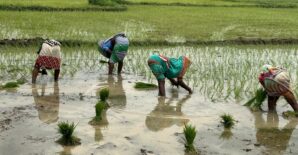The Covid-19 pandemic is probably the biggest threat to health that people across the globe are facing. More than the threat to health is the challenge it poses to the global economy. The chief of International Monetary Fund said, “The global economy has now entered a recession that could be as bad or worse than the 2009 downturn". Several countries are working tirelessly to save their citizens through announcing the economic packages to keep their economies afloat. The panic from the outbreak is so intense that the supply chains of even the agriculture sector that provides food - the most fundamental need of every human being - have been curbed. The lockdown imposed in several countries is essential to maintain social distancing and help flatten the curve. While imposing these policies, overlooking the agriculture sector could turn out to be the biggest blunder.
The impact of coronavirus on agriculture is already being felt. The Food and Agriculture Organization (FAO) food price index, which records monthly changes in the international prices of commonly-traded food commodities, averaged 180.5 points in February, 1% lower than in January. It is worth noting that the fall in food prices in February is the first recorded incidence in the last four months. The outbreak is likely to lead to worse news in the coming months for India’s major staple crop wheat. According to FAO, wheat prices were already fetching lower prices, partly due to the continued well-supplied markets. However, the negative impact on demand resulting from the spread of the coronavirus (which causes the Covid-19 disease) has further contributed to the decline in prices. This is bad news for the Indian farmers when wheat production in the country this year is likely to have gone up to a record 106.21 million tonnes. The report suggests that the price of maize has also slumped primarily because of expectations of less demand from the feed sector. The prices in the Indian maize market are likely to further plummet. Reports of Bird Flu in some locations and the wrongly-held belief that eating non-vegetarian food can cause coronavirus further reduced the demand for maize for feed.
Although the retail prices of perishable vegetables have gone up, the wholesale prices have fallen by 15-20% because of reduction in demand. The panic-buying and hoarding which resulted from the announcement of lockdown have pushed the prices of vegetables up by 20-30%. This increase in price is attributed to logistics management.
Price rise is not immediately alarming but the prices of perishable agri-products can increase after a fortnight or a month due to limited availability. Transactions at large mandis have been severely impacted due to the lockdown. The products are no longer being unloaded and redistributed to various places with the usual speed which is normally required to reach the vendors. For example, Azadpur Mandi in New Delhi, Asia’s largest mandi for fruit and vegetables, which receives 5,000-8,000 trucks daily and does about 23,000 transactions per day, is not able to execute even 25% of its capacity.
On the one hand, this creates a scarcity of fruit and vegetables in cities that depend on mandis for their supplies. On the other hand, the post-harvest losses increase significantly because of delayed handling and transaction. One can imagine the extent of loss now, when one knows that the total post-harvest loss in normal circumstances in India for fruits and vegetable is to the tune of 30%. Unfortunately, farmers, hundreds of kilometers away from the mandis, are unaware of what is going on in the mandis and they are bearing the brunt of the coronavirus outbreak.
The pandemic and the subsequent lockdown imposed are breaking the functional sequence of agricultural produce movement, that is, production – distribution – consumption. The impact of trucks stranded with agricultural products is now being felt. However, this experience would be felt more widely during the next cycle when these trucks will not reach the stipulated farms where they are expected to transport the succeeding cycle of harvest.
Reports from Madhya Pradesh are harrowing; farmers are ready to harvest wheat but there are no buyers. The situation is similar in Punjab where farmers have harvested and packed their produce, but arhatiyas (commission agents) are not ready to accept the produce and they are advising farmers to store their produce with themselves. Farmers in Bihar are ready with matured banana, but no transporter is ready to take their produce. The situation is likely to worsen in the coming days.
We do not foresee an improvement in the status of mandis, farmers, and their products during the forthcoming procurement season of wheat in the post-lockdown situation. There is uncertainty of the market closure and continuation of public procurement. Supply chain management, procurement, and distribution of agri-produce, to which farmers are generally not related, are affecting farmers the most. Although other players too are getting affected, the economic loss that the farmers must bear far outweighs the rest in the supply chain. Farmers may not have been infected by Covid-19 but have certainly been affected through the disruption of the supply chain.
The agriculture labour market has already been massively impacted. Not allowed to work in groups, 30 million agricultural labourers, who survive on their daily income, are without work. The situation has been aggravated in many parts of the country where there are specialized farm practices which are usually done by the manual labourers, who are migrant workers. The lockdown and the resultant return of these migrant labourers to their native villages are certainly going to affect agriculture adversely in the coming months. India lacks farm mechanization and about 60% of farm activities are still manually executed.
Post-pandemic and once the lockdown is lifted, farmers still won’t have much respite. The outbreak of Covid-19 is to be blamed for the ongoing situation, but if we continue to undermine agriculture and Indian farmers, the government will certainly be judged for their harrowing situation in due course of time.
Historically, in times of crisis, the agriculture market becomes particularly volatile and a site of public protest and anger. A payment of Rs. 2,000 to the farmers by April is a welcome step. However, considering the losses to the farmers, it’s a paltry amount. We need to make arrangements to ensure the continuance of agricultural operations, to prevent the danger of food and nutrition insecurity. We need to take immediate measures to support the farmers for the continuity of uninterrupted agricultural movement. We cannot afford to wait for the lockdown to lift before initiating relief efforts.
Anjani Kumar is Research Fellow at International Food Policy Research Institute, South Asia Office, New Delhi and Niraj kumar is Dean at the Development Management Institute, Patna .Views expressed are personal.
This article was originally published in Live Mint here.




